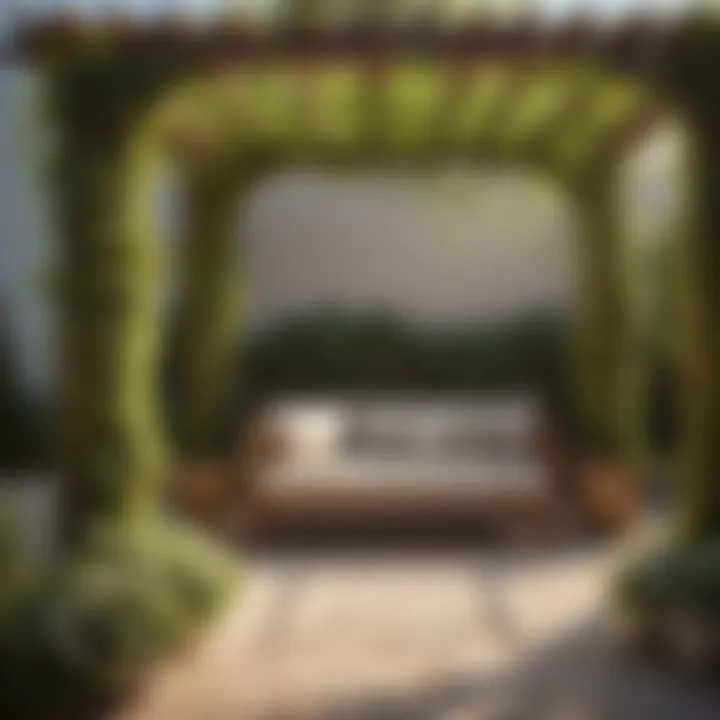Materials:
- Pressure-treated lumber: 8 pieces of 4x4x8ft, 12 pieces of 2x6x12ft
- Galvanized screws: 3in and 2.5in
- Concrete mix: 8 bags
- Gravel: 2 cubic yards
- Metal post bracket anchors: 8
DIY Steps:
-
Planning: Measure and mark the area for the shade structure, ensuring it fits your outdoor space aesthetically.
-
Foundation: Dig holes at marked spots and pour concrete mix, placing metal post bracket anchors for stability.
-
Frame Assembly: Cut lumber to required dimensions, and assemble the frame using galvanized screws for durability.
-
Roof Installation: Add cross beams and rafters for the roof, providing the desired amount of shade.
Technical Aspects:
- Tools Needed: Circular saw, drill, spirit level, measuring tape.
- Timing: Approx. 2 days for assembly, excluding concrete curing time.
- Critical Techniques: Ensure precise measurements for a stable structure, use a spirit level for accuracy.
DIY Project Process:

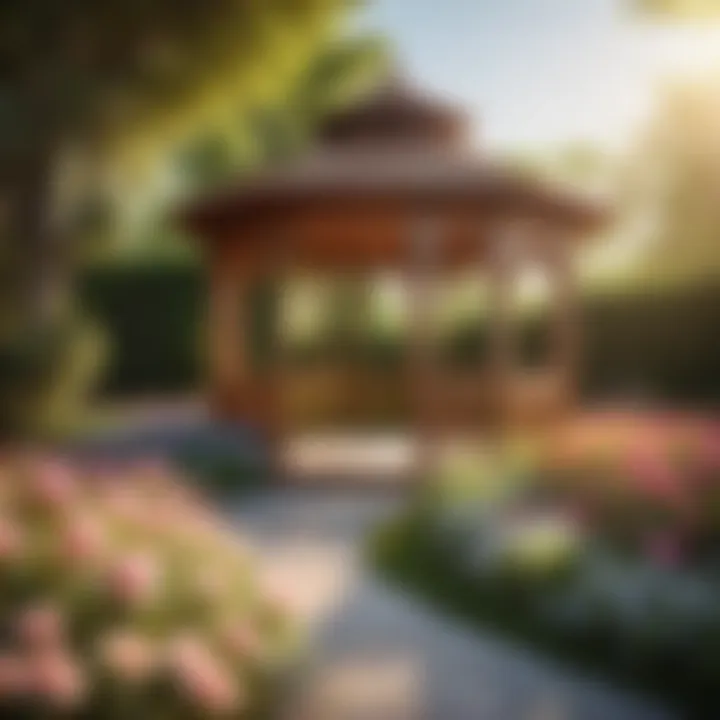
-
Foundation Setup: Follow the manufacturer's guidelines for mixing and pouring concrete, ensuring proper alignment of anchor brackets.
-
Frame Construction: Secure the vertical posts first, then add horizontal beams, ensuring everything is level and squared.
-
Roofing: Install rafters at regular intervals, attaching them securely to the frame while ensuring consistent spacing.
Troubleshooting Tips:
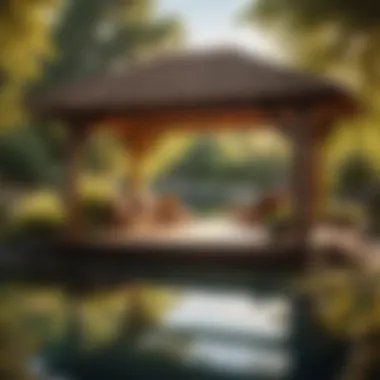
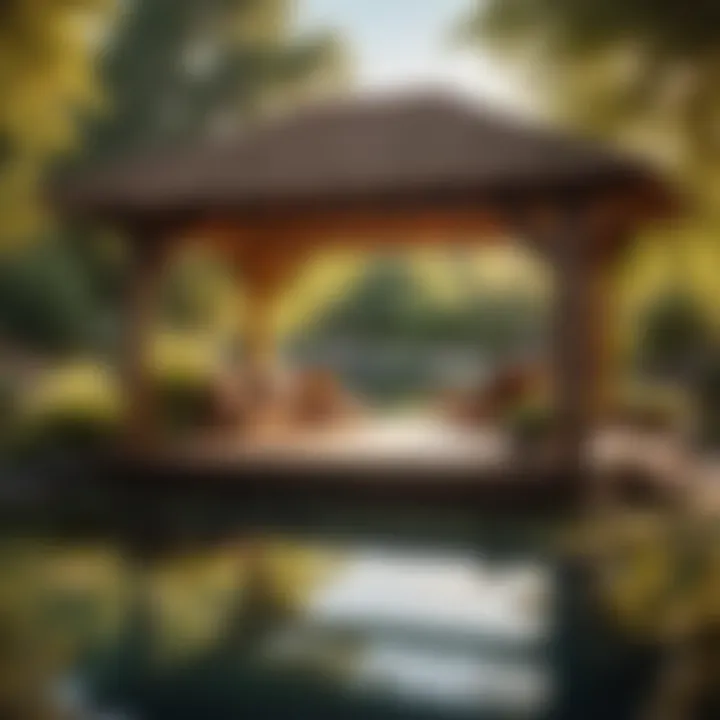
- If the structure feels unstable, double-check the alignment of posts and the depth of the foundation holes.
- For warped lumber, soak in water and clamp for a day to regain straightness.
This detailed guide offers comprehensive instructions, enabling you to create a sturdy and visually appealing wooden shade structure for your backyard.
Introduction

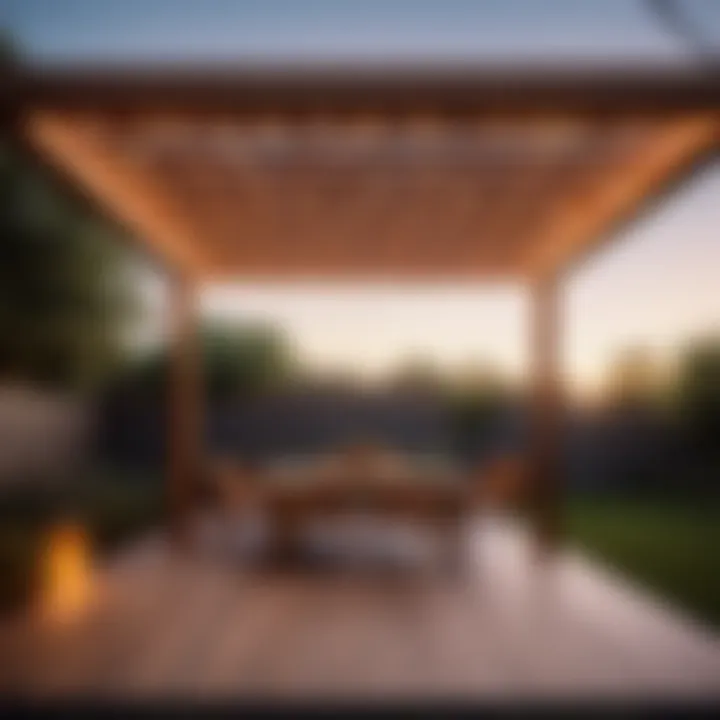
In the realm of outdoor living, the allure of backyard wooden shade structures holds a pivotal role. As we embark on this journey exploring the intricacies of these structures, we uncover a world where functionality seamlessly merges with aesthetics, and practicality intertwines with style. From the idyllic charm of pergolas to the classical elegance of gazebos and the minimalist beauty of arbors, each wooden shade structure brings its own unique essence to outdoor spaces, elevating them to new heights of sophistication and comfort.
Defining Wooden Shade Structures
Pergolas
Pergolas stand as elegant focal points in outdoor settings, offering not only shade from the sun but also a touch of architectural refinement. Their open-beam roofs create a play of light and shadow, adding a dynamic element to the space beneath. Pergolas are revered for their versatile design, providing a backdrop for climbing plants and vines to weave their way through, enhancing the natural ambiance of the surroundings. While pergolas excel in their ability to define outdoor living areas, their openness leaves them vulnerable to the elements, requiring consideration of weather exposure in their placement and design.
Gazebos
Gazebos exude a sense of grandeur and enchantment, serving as tranquil retreats within the backyard oasis. Their enclosed structures offer shelter from sun and rain, fostering a cozy setting for relaxation and social gatherings. With intricate details in their design, such as latticework and spindles, gazebos provide a whimsical charm that complements any outdoor landscape. While gazebos excel in providing a cozy retreat, their solid roofs limit natural light penetration, necessitating thoughtful placement to maintain a balance between shade and illumination.
Arbors
Arbors present a delicate fusion of functionality and aesthetics, acting as whimsical entryways or standalone accents in outdoor spaces. Their latticed sides and rooftops serve as perfect supports for climbing plants, creating a picturesque frame that guides movement through the garden. Arbors are prized for their ability to delineate walkways or accentuate focal points within the landscape, adding a touch of romance to the overall design. However, their smaller footprint may limit their shading capacity, making them more suitable for decorative purposes rather than extensive sun protection.
Benefits of Wooden Shade Structures
Shelter from Sun and Rain
Wooden shade structures offer a retreat from the harsh sun and unpredictable rain, providing a shaded sanctuary for outdoor activities. The strategic placement of these structures can create comfortable environments for relaxation and social gatherings, shielding individuals from excessive heat or sudden downpours. While wooden shade structures excel at offering protection, they require periodic maintenance to uphold their structural integrity and weather resistance.
Enhanced Aesthetics
In addition to their practical function, wooden shade structures enhance the visual appeal of outdoor spaces, infusing them with a sense of charm and sophistication. Whether adorned with intricate details or left in a natural finish, these structures harmonize with the surrounding landscape, creating cohesive and inviting outdoor living areas. While wooden shade structures elevate aesthetics, their aesthetic impact may vary depending on the chosen wood type and design style.
Increase Property Value
The presence of well-designed wooden shade structures can significantly enhance the overall value of a property. These structures augment the appeal of outdoor living spaces, increasing their functionality and aesthetic appeal, which can attract potential buyers and elevate the property's market value. However, while wooden shade structures offer value enhancement, their installation and maintenance costs should be factored into the property value equation to ensure a balanced return on investment.
Design Options
Design options play a crucial role in the realm of backyard wooden shade structures. They encompass a range of elements that deeply influence the functionality, aesthetics, and overall appeal of these outdoor features. Selecting the right design can enhance the practicality of your space while elevating its visual charm. In this section, we will delve into specific aspects, benefits, and considerations related to design options.
Choosing the Right Wood
Cedar
Cedar stands out as a preferred choice for wooden shade structures due to its remarkable durability and natural resistance to decay and insect infestations. Its key characteristic lies in its longevity, making Cedar a popular option for outdoor applications. The unique feature of Cedar is its distinct aroma and beautiful grain patterns, adding a touch of elegance to any backyard setting. While Cedar boasts impressive longevity and aesthetic appeal, it requires periodic maintenance to preserve its rich color and structural integrity.
Redwood
Redwood is renowned for its exceptional strength and stability, making it an ideal choice for wooden shade structures. The key characteristic of Redwood is its natural beauty, with a rich, reddish-brown hue that weathers gracefully over time. This wood species is valued for its resistance to warping and shrinking, ensuring long-lasting performance in outdoor environments. The unique feature of Redwood lies in its ability to showcase a diverse range of grain patterns, enhancing the visual interest of any structure. While Redwood offers outstanding durability and aesthetics, it falls on the higher end of the pricing spectrum compared to other wood options.
Pressure-Treated Pine
Pressure-treated pine is a cost-effective and practical choice for wooden shade structures, thanks to its affordability and ease of availability. The key characteristic of pressure-treated pine is its resistance to rot, decay, and termite damage, making it a suitable option for outdoor use. The unique feature of this wood type is its treated composition, which enhances its durability and longevity in various weather conditions. While pressure-treated pine offers a budget-friendly solution for outdoor projects, it may lack the visual appeal and natural beauty associated with premium wood species.
Structural Configurations
Open-Top Designs
Open-top designs provide a spacious and airy feel to wooden shade structures, allowing natural light to filter through while offering partial shade. The key characteristic of open-top designs is their versatility, as they can accommodate climbing plants for added aesthetics. The unique feature of this configuration is the opportunity to customize the level of shade by adjusting the spacing between overhead slats. While open-top designs promote ventilation and openness, they may offer limited protection from intense sunlight or rain.
Solid Roof Structures
Solid roof structures offer complete coverage and protection from the elements, delivering a sheltered space for outdoor relaxation and entertainment. The key characteristic of solid roof structures is their all-weather functionality, ensuring a comfortable outdoor experience throughout the year. The unique feature of this configuration is the potential for incorporating additional features like ceiling fans or lighting fixtures to enhance comfort and convenience. While solid roof structures provide excellent weather protection, they may reduce natural light penetration and ventilation compared to open-top designs.
Combination Designs
Combination designs merge the benefits of open-top and solid roof structures, offering a versatile and customizable solution for backyard shade. The key characteristic of combination designs is their ability to balance light exposure and weather protection based on specific preferences. The unique feature of this configuration is the flexibility to adjust the coverage area by integrating retractable canopy or panels. While combination designs provide versatility and adaptability, they may require more complex installation and maintenance due to their hybrid nature.
Installation Process
Preparing the Site
Leveling the Ground
In the realm of preparing the site for a wooden shade structure, leveling the ground is a fundamental step that sets the foundation for a sturdy and balanced installation. Leveling the ground involves meticulously flattening the surface to create a uniform base for the structure. This process is essential as it ensures stability, prevents structural issues, and enhances the overall aesthetic appeal of the area. The key characteristic of leveling the ground lies in its ability to create a safe and even surface for the structure. This ensures that the wooden shade structure is securely anchored and withstands environmental factors over time. While leveling the ground may require time and effort, the benefits it offers in terms of structural integrity and longevity make it a popular choice for this article. The unique feature of leveling the ground is its capability to mitigate uneven terrain, thereby providing a solid groundwork for the wooden shade structure. Despite the initial labor involved, the advantages of a leveled surface far outweigh any temporary inconveniences, making it a worthwhile investment in the longevity of the structure.
Checking for Utilities
Another critical aspect of preparing the site is checking for utilities to avoid any obstruction or potential hazards during the installation process. By assessing the location for existing utilities such as water pipes, gas lines, or electrical wiring, you can prevent accidental damage and ensure a smooth installation process. The key characteristic of checking for utilities is its proactive approach in identifying hidden infrastructure that could impact the structural integrity or safety of the wooden shade structure. This precautionary measure is a beneficial choice for this article as it emphasizes the importance of thorough site examination before proceeding with the installation. The unique feature of checking for utilities lies in its ability to safeguard against unforeseen complications that could arise from underground installations. While this step may require additional time and attention to detail, the advantages of preemptive planning outweigh the risks of overlooking potential hazards.
Assembling the Structure
Anchoring Posts
When it comes to assembling the wooden shade structure, anchoring posts is a critical phase that determines the stability and durability of the entire construction. Anchoring posts involves securing the vertical supports into the ground with precision to provide a robust foundation for the structure. The key characteristic of anchoring posts is their anchoring capability, which ensures the structure remains firm and upright even in challenging weather conditions. This feature is a beneficial choice for this article as it highlights the importance of structural support in maintaining the integrity of the wooden shade structure. The unique feature of anchoring posts lies in their ability to distribute weight evenly and withstand external forces, contributing to the longevity of the installation. While anchoring posts may require strategic planning and labor-intensive effort, the advantages of a well-supported structure outweigh the initial investment in time and resources.
Attaching Beams and Rafters
Another crucial aspect of assembling the wooden shade structure is attaching beams and rafters, which form the framework of the overall design. Attaching beams and rafters involves connecting the horizontal and diagonal elements of the structure to create a cohesive and functional configuration. The key characteristic of attaching beams and rafters is their role in providing structural stability and visual appeal to the wooden shade structure. This choice is popular for this article as it showcases the importance of structural configurations in enhancing the overall aesthetics and functionality of the installation. The unique feature of attaching beams and rafters lies in their versatility to accommodate various design styles and preferences, allowing for customization and personalization of the outdoor space. While the process of attaching beams and rafters may require careful measurement and alignment, the advantages of a well-structured framework offer a rewarding outcome in terms of visual impact and structural integrity.
This detailed guide on the installation process of backyard wooden shade structures provides a comprehensive overview of the critical steps and considerations involved in creating a functional and stylish outdoor space. By delving into the nuances of site preparation, structural assembly, and maintenance, readers can embark on their journey to transform their backyard into a tranquil oasis.
Maintenance Tips
When it comes to wooden shade structures in your backyard, proper maintenance is key to ensure longevity and aesthetics. Regular inspections and appropriate care can prevent issues and keep your structure looking pristine. Maintenance Tips play a crucial role in extending the lifespan of your wooden shade structure and preserving its appeal over time.
Regular Inspections
Checking for Rot
Checking for rot is a vital aspect of maintaining wooden shade structures. Rot can weaken the wood, compromising the integrity of the entire structure. Regularly inspecting for signs of rot such as discoloration, soft spots, or fungal growth is essential to address any decay promptly. By catching and addressing rot early, you can prevent further damage and prolong the lifespan of your structure. Utilizing moisture meters can also help in detecting hidden moisture that may contribute to rot.
Rot inspection is a popular choice for proactive homeowners looking to preserve the quality of their wooden shade structures. Its key characteristic lies in its ability to identify potential issues before they escalate, helping homeowners save on costly repairs in the long run. However, it requires meticulous attention to detail and a thorough understanding of wood decay processes.
Inspecting fasteners is another crucial aspect of maintenance for wooden shade structures. Fasteners like screws and nails can loosen over time due to weather exposure and structural shifts. Regularly checking and tightening fasteners ensures the structural stability of your wooden shade structure. Loose fasteners can lead to structural compromise and safety hazards, making inspections a critical maintenance task.
Staining and Sealing
Recommended Products
Choosing the right stain and sealant products is essential for protecting wooden shade structures from the elements. Recommended products offer durability, UV protection, and water resistance to maintain the integrity of the wood. High-quality products help enhance the natural beauty of the wood while providing long-lasting protection against weathering.
Recommended products are a popular choice among homeowners seeking to preserve the aesthetics and structural integrity of their wooden shade structures. Their key characteristic lies in their ability to penetrate the wood fibers and create a protective barrier against moisture and UV rays. Choosing reputable brands known for their quality ensures optimal results and prolonged protection.
Frequency of application is key when it comes to staining and sealing wooden shade structures. Regularly reapplying stain and sealant in accordance with manufacturer guidelines is crucial for maintaining a protective layer on the wood. The frequency may vary depending on exposure to elements and wear, with some products requiring annual application for optimal protection.

